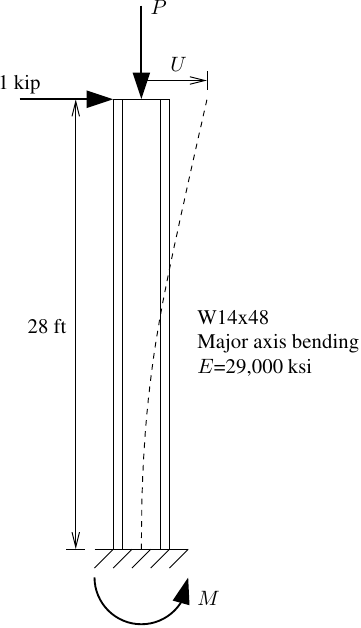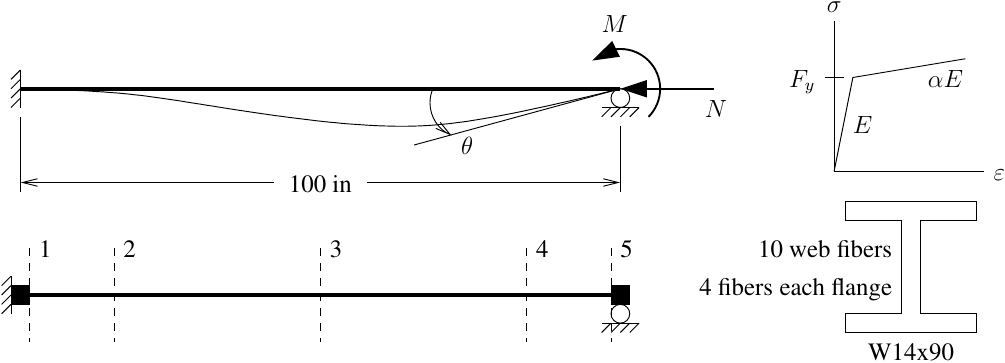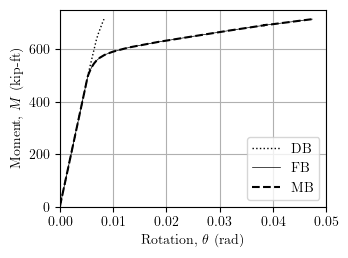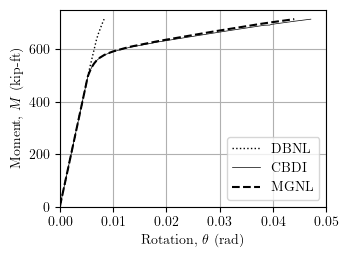OpenSees Cloud
OpenSees AMI
There's Three, Actually
Original Post - 13 Jun 2021 - Michael H. Scott
Show your support at Buy Me a Coffee.
The displacement-based and force-based formulations garner a lot of comparisons for simulating nonlinear frame response. My Google Scholar alerts tell me so. And I even wrote a post comparing the two formulations.
IMAGE
There is a third formulation–the mixed formulation. Alemdar and White (2005) compared three frame element formulations (displacement-based, force-based, and mixed). In the OpenSees world, however, the mixed formulation has been largely ignored because this element was never implemented in the framework.
It turns out that’s not the case. Mark Denavit implemented the Alemdar and White mixed formulation (2D and 3D versions) in OpenSees in 2010. The elements were merged in to the main OpenSees repository in March 2020 (PR #264).
A subsequent PR (#411)
modified the mixedBeamColumn elements to use BeamIntegration objects so
that the element has the same input format as dispBeamColumn and
forceBeamColumn.
ops.element('mixedBeamColumn',eleTag,ndI,ndJ,transfTag,beamIntTag)
The mixed element also handles geometric nonlinearity (“P-little delta”)
inside the basic system and this can be enabled using the
-geomNonlinear input flag.
ops.element('mixedBeamColumn',eleTag,ndI,ndJ,transfTag,beamIntTag,'-geomNonlinear')
Rather than go through the details of the mixed formulation, I’ll show a few examples and some things to do when test driving an element formulation. Along the way, I’ll also compare the mixed element with its displacement-based and force-based companions.
First, let’s do some sanity checks with simple span, linear-elastic beams. Each beam uses three Gauss points with elastic sections defined by E, A, and I. Let’s say a W24x76 over a span of L=20 ft, with Mo=800 kip-ft for loading A and w=1.8 kip/ft for loading B.

For each loading, the end rotation (using nodeDisp) and mid-span bending
moment (using sectionForce) are compared to the exact solution.
| Loading | Exact theta, M2 (rad, kip-in) | Mixed (MB) | FB | DB |
|---|---|---|---|---|
| A | 0.0126, 4800 | 0.0126, 4800 | 0.0126 4800 | 0.0126, 4800 |
| B | 0.00142, 1080 | 0.00142, 1080 | 0.00142, 1080 | 0.00142, 720 |
Like the force-based element, the mixed element gives the correct internal bending moment with member loads. This is a good thing. Also, the displacement-based element uses equivalent nodal loads, so the internal bending moment at mid-span does not match the expected solution for loading B.
Turning to geometric nonlinearity, below is benchmark problem Case 2 from Commentary Chapter C of the AISC Steel Manual. This problem was examined in a previous post.

The lateral displacement, U, and base moment, M, from an analysis using
the geometrically nonlinear mixed formulation, the force-based CBDI
formulation (forceBeamColumnCBDI), and a nonlinear displacement-based
formulation (dispBeamColumnNL, with Green-Lagrange strain) are shown
below. The analyses do not include shear deformation.
| P (kip) | Exact U, M (inch, kip-inch) | Mixed (MGNL) | CBDI | DBNL | No P-little delta |
|---|---|---|---|---|---|
| 0 | 0.901, 336 | 0.901, 336 | 0.901, 336 | 0.901, 336 | 0.901, 336 |
| 100 | 1.33, 469 | 1.33, 469 | 1.33, 469 | 1.33, 469 | 1.23, 459 |
| 150 | 1.75, 598 | 1.75, 599 | 1.75, 599 | 1.74, 598 | 1.51, 562 |
| 200 | 2.56, 848 | 2.56, 849 | 2.56, 849 | 2.53, 843 | 1.94, 724 |
The results look very good as the effects of P-little delta increase with increasing axial load. Even the nonlinear displacement-based element does a good job.
Moving on to material nonlinearity, below is a propped cantilever with fiber discretized cross-sections. The material properties are E=29,000 ksi, _Fy=50 ksi and \(\alpha\)=0.005. The numerical integration is five Gauss-Lobatto points for all three element formulations. This is the same model (with some minor tweaks) used in this post which compared the displacement-based and force-based formulations.
The axial load is held constant at N=0.2Fy while the applied moment increases from zero to M=1.2SxFy.


The displacement-based analysis uses only one element for the member, so the results are poor, as expected. We see that the mixed formulation gives the same response as the force-based formulation; however, I doubt this will always be the case.
Just for fun, turning on geometric nonlinearity in the mixed element and switching the displacement-based and force-based elements to DBNL and CBDI, respectively, gives the results shown below for the propped cantilever. The simulation combines material and geometric nonlinearity, but there’s not a big change in results compared to the case of only material nonlinearity–this column is not at all slender.

More examples should be done, especially assessing the performance of the mixed formulation in models of reinforced concrete structures. But, so far, I’d say the mixed element implementation in OpenSees is very good. Give it a try and let me know what you think.